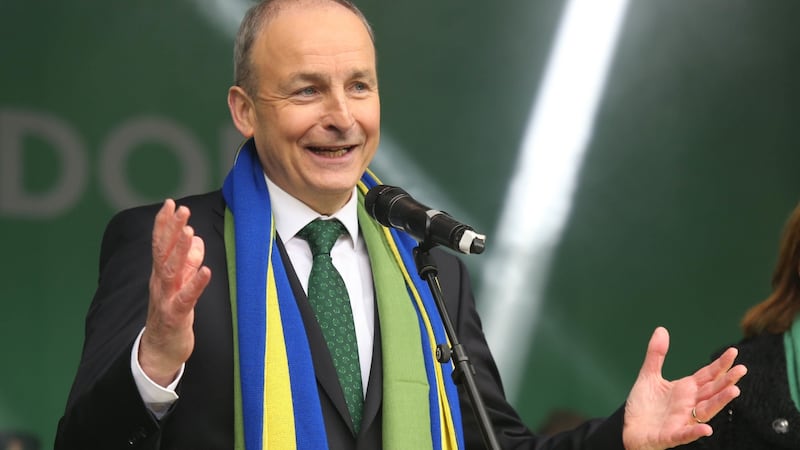As a consequence of war in Europe, St Patrick's Day will not be as green as usual this year. Other colours take symbolic priority, and it is obvious why. Celebratory assertions of national pride might be perceived as vapid and incongruous when it's another country being vacuum-bombed.
So the 13th annual Global Greening – the lighting up of hundreds of monuments and sites around the world – has been suspended, with Taoiseach Micheál Martin asking Irish Embassies to encourage participating landmarks to shine in the blue and yellow of Ukraine instead.
In some countries this request will find favour, in others it won't. Some landmarks could choose to dissolve green lights to blue and yellow ones. Others with unbroken links to Russia will likely stick to their standard illuminations rather than express solidarity with a country Vladimir Putin is attempting to shell out of existence.

That certain national identities are deemed less controversial than others – by regimes that permanently host more Irish pubs than polling stations, for instance – is a facet of world affairs that has both contributed to the success of Global Greening and could now hinder this bid to ally it to sympathy for Ukraine.
The first sign that the Department of Foreign Affairs and Tourism Ireland were minded to adjust their plans came on day four of Russia's invasion, when the launch of the 2022 greening was cancelled with 24 hours' notice. It had been due to be attended by Minister for Tourism Catherine Martin and Tourism Ireland chief executive Niall Gibbons.
In recent years several Russian landmarks have gone green on March 17th. In 2019, a trio of Moscow buildings did: the Central Telegraph Building, Izvestia Hall and Rossiya Theatre. In 2020, Krymsky Bridge in the capital and St Petersburg’s Palace Bridge joined in, though in 2021, it was the Palace Bridge in Putin’s home town that was the sole Russian participant.
This year no Russian or Ukrainian landmarks were destined to be involved, but the department and Tourism Ireland still wisely concluded that pushing this now familiar strand of St Patrick’s Day marketing would be inappropriate. Many world-famous monuments, from the Eiffel Tower to the Empire State Building, have only just been lit in Ukrainian colours after all.
That these blue-and-yellow tinges are of limited use to the Ukrainian fightback – and outright hollow gestures in the case of 10 Downing Street and the “world-beating” chaos of its Ukrainian visa scheme – is beside the point. For Ireland to say “it’s our turn now, guys” would have seemed a bit tacky.
Online attention
Clearly the risk of merrily green-lit sites competing for attention online with visual evidence of even more depressing barbarity than that witnessed to date was also just too high.
But it has taken something as shocking as what Russia is doing to Ukraine to force a rethink on what is, in “normal” times, a brilliant idea that has worked a treat for Tourism Ireland since 2009.
The cleverness of the Global Greening spectacle lies in its simplicity, its scalability and its sheer repeatability.
In non-crisis years a parade of greened-up tourist hotspots and would-be tourists hotspots have racked up festivals of what is known fondly by publicity professionals as "earned media", meaning news outlet content and organic social media posts for which it has not been necessary to directly pay. (Compensation is typically made to some global attractions for taking part.) Lighting up a monument in lurid, Kermit-esque green does not say very much if you think about it, but it looks great on an Instagram feed. And who does not love Kermit?
Like everything else about St Patrick’s Day, the message each individual greening does transmit will often resonate more with people outside Ireland than people who reside here.
From the perspective of this island, the annual projections can feel a touch “you love us, and we want more than anything to be loved”. That’s fine if you’re fully immune to cultural cringe.
The sight of, say, Rio de Janeiro’s Christ the Redeemer statue glowing green might even seem an achievement in itself if you’re prone to Irish exceptionalism and don’t dwell too hard on the behind-the-scenes work that goes into it.
To overseas-based eyes, however, those green lights are an unpretentious recognition of the Diaspora. They acknowledge connections and communities that for tens of millions have the good fortune to be both meaningful and joyful – perhaps especially so for second-generation and third-generation people of Irish heritage whose experience of Ireland is uncomplicated by the realities of ever living here.
With in-person St Patrick’s Day events and gatherings cancelled in 2020 and 2021 and non-essential air travel almost completely impossible last March, the Global Greening was also coming into its own as both a pandemic-safe way to promote Ireland and a doable means to offer “positivity and hope”, as Gibbons put it, to Irish people who could not get home.
Darkened mood
Now the mood has darkened across Europe to the point where an innocuous lighting display could do more harm than good.
The Taoiseach spent Sunday morning politely fielding the BBC’s questions about Irish neutrality, stressing that Ireland was not politically or morally neutral on Ukraine and suggesting that Irish military neutrality would be something to “reflect on” in future. As far as Brand Ireland is concerned, this is new.
So far, of course, only the colours have changed. For the London festivities that followed, Martin wore a shamrock-patterned green tie, actual shamrock on his lapel and a scarf in a mossy shade of green. Above it, rested a second, more prominent scarf in blue and yellow.
Green may still be the primary colour of this St Patrick’s Day, but it would be wrong for it not to share the light.











